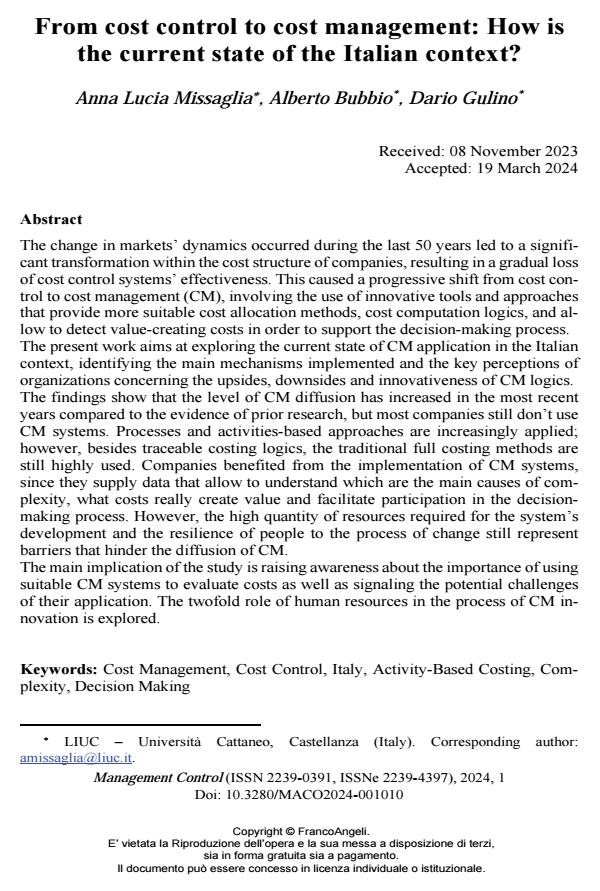From cost control to cost management: How is the current state of the Italian context?
Titolo Rivista MANAGEMENT CONTROL
Autori/Curatori Anna Lucia Missaglia, Alberto Bubbio, Dario Gulino
Anno di pubblicazione 2024 Fascicolo 2024/1
Lingua Inglese Numero pagine 24 P. 203-226 Dimensione file 298 KB
DOI 10.3280/MACO2024-001010
Il DOI è il codice a barre della proprietà intellettuale: per saperne di più
clicca qui
Qui sotto puoi vedere in anteprima la prima pagina di questo articolo.
Se questo articolo ti interessa, lo puoi acquistare (e scaricare in formato pdf) seguendo le facili indicazioni per acquistare il download credit. Acquista Download Credits per scaricare questo Articolo in formato PDF

FrancoAngeli è membro della Publishers International Linking Association, Inc (PILA)associazione indipendente e non profit per facilitare (attraverso i servizi tecnologici implementati da CrossRef.org) l’accesso degli studiosi ai contenuti digitali nelle pubblicazioni professionali e scientifiche
The change in markets’ dynamics occurred during the last 50 years led to a signifi-cant transformation within the cost structure of companies, resulting in a gradual loss of cost control systems’ effectiveness. This caused a progressive shift from cost control to cost management (CM), involving the use of innovative tools and approaches that provide more suitable cost allocation methods, cost computation logics, and allow to detect value-creating costs in order to support the decision-making process. The present work aims at exploring the current state of CM application in the Ital-ian context, identifying the main mechanisms implemented and the key percep-tions of organizations concerning the upsides, downsides and innovativeness of CM logics. The findings show that the level of CM diffusion has increased in the most recent years compared to the evidence of prior research, but most companies still don’t use CM systems. Processes and activities-based approaches are increasingly ap-plied; however, besides traceable costing logics, the traditional full costing methods are still highly used. Companies benefited from the implementation of CM sys-tems, since they supply data that allow to understand which are the main causes of complexity, what costs really create value and facilitate participation in the de-cision-making process. However, the high quantity of resources required for the system’s development and the resilience of people to the process of change still represent barriers that hinder the diffusion of CM. The main implication of the study is raising awareness about the importance of using suitable CM systems to evaluate costs as well as signaling the potential chal-lenges of their application. The twofold role of human resources in the process of CM innovation is explored.
Parole chiave:Cost Management, Cost Control, Italy, Activity-Based Costing, Com-plexity, Decision Making
Anna Lucia Missaglia, Alberto Bubbio, Dario Gulino, From cost control to cost management: How is the current state of the Italian context? in "MANAGEMENT CONTROL" 1/2024, pp 203-226, DOI: 10.3280/MACO2024-001010